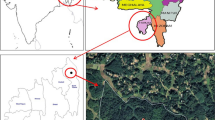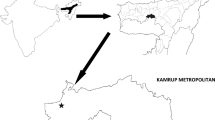Abstract
A study was conducted at two-biodiversity conservation areas of Northeastern Bangladesh (a part of Sylhet Forest Division) to assess the species composition, diversity and density of natural regeneration of tree species both indigenous and exotic species. Data were collected by stratified random quadrate method during January 2010 to July 2010. Totally 200 circular plots of 2 m×2 m in size had 5 different habitat types of plants namely; forest, roadside, homestead (surrounding forest dwellers house), fallow land and others (canals, streams and tea gardens side), which included a total of 55 regenerating species belonging to 28 families. Meliaceae is the dominant family and shows the highest family importance value (26.3), having six species, followed by Moraceae (24.24). Among the five habitat types, forest (43 species) possess the highest number of species, followed by roadside (23 species). Total 15 exotic species among 9 families and 40 indigenous species with 24 families were recorded. For exotic species, Tectona grandis possess the highest relative density (11.7%) and relative frequency (10.5%); Senna siamea had highest relative abundance (7.83%). In case of indigenous species, Chickrassia tabularis possess the highest relative density (4.23%) and relative frequency (4%); Dipterocarpus turbinatus had the highest relative abundance (3.92%). Tectona grandis (29.66) and Chickrassia tabularis (10.8) had the highest IVI for exotic and indigenous species respectively. Different diversity indices such as Shanon-Winner diversity index, species diversity index, species richness index, species evenness index, Simpson index and species dominance index, etc. were applied to quantify definite diversity. The regeneration of species associated with low levels of disturbance was in the exotic species. Study suggests that proper protection from human disturbances and scientific management of natural regeneration of two-study forests may lead a rich biodiversity site in the country.
Similar content being viewed by others
References
Ahmed GU, Bhuyian MK. 1994. Regeneration status in the natural forests of Cox’s Bazar forest division, Bangladesh. Annals of Forest, 2: 103–108.
Alamgir M, Al-Amin M. 2007. Regeneration Status in a Proposed Biodiversity Conservation Area of Bangladesh. Proceedings of the Pakistan Academy of Sciences, 44(3): 165–172.
Ashton PS, Hall P. 1992. Comparisons of structure among mixed dipterocarp forests of northwestern Borneo. Journal of Ecology, 80: 459–481.
Barua SP, Khan MMH, Reza AHMA. 2001. The Status of Alien Invasive Species in Bangladesh and their Impact on the Ecosystems. In: P. Balakrishna (eds.), Alien Invasive Species-Report of workshop on Alien Invasive Species. Colombo, Sri Lanka: IUCN Regional Biodiversity Programme of Asia, pp. 1–7.
BBS/UNDP. 2005. Compendium of Environment statistics of Bangladesh. Bangladesh Bureau of Statistics/United Nations Development Programme, Ministry of Planning, Government of the People’s Republic of Bangladesh, pp. 11–227.
BFD (Bangladesh Forest Department). 2008. Ministry of Environment and Forest, Government of Bangladesh, Dhaka. Available from: http://www.bforest.gov.bd. [Accessed 13 June 2010].
Brandis D. 1906. Indian Trees. Delhi: Periodical Experts Book Agency, p.767.
Cao M, Zhang JH, Feng Z, Deng J, Deng X. 1996. Tree species composition of a seasonal rain forest in Xishuangbanna, South West China. Tropical Ecology, 37(2): 183–192.
Chowdhury MSH, Koike M. 2010. An overview on the protected area system for forest conservation in Bangladesh. Journal of Forestry Research, 21(1): 111–118.
Chowdhury QI. 2001. Bangladesh: State of Bio-diversity. In: Forum of Environmental Journalists of Bangladesh (FEJB). Dhaka: Shegun Bagicha, Bangladesh, pp. 9–15.
Das DK, Alam MK. 2001. Trees of Bangladesh. Bangladesh Forest Research Institute, (BFRI). Chittagong: The Art Press, Bangladesh, pp. 18–267.
Dey TK. 2006. Useful Plants of Bangladesh (2nd Edition). Chittagong: The Add. Communication, press, Bangladesh, pp. 546–567.
Duchok R, Kent K, Khumbongmayum AD, Paul A, Khan ML. 2005. Population structure and regeneration status of medicinal tree Illicium griffithii in relation to disturbance gradients in temperate broad-leaved forest of Arunachal Pradesh. Current Science, 89(4): 673–676.
FAO (Food and Agriculture Organization). 2007. State of the World’s Forests 2007. Rome: Food and Agriculture Organization (FAO) of the United Nations, Italy, pp. 116–118.
Gunatilleke CVS, Weerasekera N, Gunatilake IAUN, Kathriarachchi HS. 2001. The role of dipterocarps, their population structures and spatial distributions in the forest dynamics plot a Sinharaja, Sri Lanka. In: K.N. Ganeshaiah, R.S. Uma and K.S. Bawa, (eds.), Tropical Ecosystem: Structure, Diversity, and Human Welfare. Proceedings of the International Conference on Tropical Ecosystems. New Delhi: Oxford and IBH Publishing, pp. 591–594.
Haque SMS, Alam MS. 1988. Some aspects of practicing the clear-felling followed by artificial regeneration system in the Cox’s Bazar Forest Division. Chittagong University Studies (Part II): Science, 12 (2): 87–95.
Heining RL. 1925. List of plants of Chittagong Collectorate and Hill Tracts. India: Darjeeling press, pp. 30–84.
Hossain M. 1994. Tree species Diversity of a Natural Forest — A study of Bamu Reserve Forest. Chittagong: Review paper No. 226, Institute of forestry and environmental sciences, Chittagong University, Bangladesh, pp. 23–45.
Hossain MK. 2001. Overview of the forest biodiversity in Bangladesh. In: Assessment, conservation and sustainable use of forest biodiversity (CBD Technical Series no. 3). Montreal, SCBD, Canada: Secretariat of the Convention on Biological Diversity, pp. 33–35.
Hossain MK. 2005. Conversion of dipterocarps-dominant natural forests to short rotation plantations- an unrecoverable threat to the native dipterocarps in Bangladesh. Available from: http://www.apafri.org/8thdip/Session%204/S4_Hossain.doc. [Accessed 13 June 2010].
Hossain MK, Azad AK, Alam MK. 1999. Assessment of natural regeneration status in a mixed tropical forest at Kaptai of Chittagong Hill Tracts (South) Forest Division. The Chittagong University Journal of Science, 23(1): 73–79.
Hossain MK, Rahman ML, Hoque ATMR, Alam MK. 2004. Comparative regeneration status in a natural forest and enrichment plantations of Chittagong (south) forest division, Bangladesh. Journal of Forestry Research, 15(4): 255–260.
Kadavul K, Parthasarathy N. 1999. Plant biodiversity and conservation of tropical semi evergreen forests in the Shervanayan hills of Eastern Ghats, India. Biodiversity and Conservation, 8: 421–439.
Kent M, Coker P. 1992. Vegetation Description and Analysis: A Practical Approach. NY, USA: John Wiley and Sons, pp. 167–169.
Khan MASA, Uddin MB, Uddin MS, Chowdhury MSH, Mukul SA. 2007. Distribution and Status of Forests in the Tropic: Bangladesh Perspective. Proceedings of the Pakistan Academy of Sciences, 44(2): 145–153.
Khan ML, Rai JPN, Tripathi RS. 1987. Population structure of some tree species in disturbed and protected sub-tropical forests of north-east India. Acta Oecologica Oeol Applic, 8(3): 247–255.
Khumbongmayun AD, Khan ML, Tripathi RS. 2005. Sacred groves of Manipur, northeast India: biodiversity value, status and strategies for their conservation. Biodiversity and Conservation, 14: 1541–1582.
Khumbongmayun AD, Khan ML, Tripathi RS. 2006. Biodiversity conservation in sacred groves of Manipur, northeast India: population structure and regeneration status of woody species. Biodiversity and Conservation, 15: 2439–2456.
Laska MS. 1997. Structure of understory shrub assemblages in adjacent secondary forest and old growth tropical wet forests, Costa Rica. Biotropica, 29: 29–37.
Magurran AE. 1988. Ecological Diversity and Measurement. New Jersey, USA: Princeton University Press, Princeton, pp. 354.
Margalef R. 1958. Information theory in ecology. General Systematics, 3: 36–71.
Michael P. 1990. Ecological Methods for Field and Laboratory Investigation. New Delhi: Tata Mc Graw Hill Publishing Co. Ltd., India, pp. 404–424.
Misra R. 1968. Ecology Workbook. New Delhi: Oxford and IBH Publishing Co. Pvt. Ltd., India, pp. 64–231.
Mittermeier RA, Myers N, Thomsen JB, Defonseca GA, Olivieri S. 1998. Biodiversity hotspots and major tropical wilderness areas: approaches to setting conservation priorities. Conservation Biology, 12: 516–520.
Mori SA, Boom BM, Carvalino AM, Santos D. 1983. The ecological importance of Myrtaceae in eastern Brazilian wet forest. Biotropica, 15: 68–70.
Muhammed N, Koike M, Haque F. 2008a. Forest policy and sustainable forest management in Bangladesh: An analysis from national and international perspectives. New Forests, 36: 201–216.
Muhammed N, Koike M, Haque F, Miah MD. 2008b. Quantitative assessment of people-oriented forestry in Bangladesh: A case study in the Tangail forest division. Journal of Environmental Management, 88: 83–92.
Mukul SA. 2007. Biodiversity Conservation Strategies in Bangladesh: The State of Protected Areas. Tigerpaper, 34 (3): 28–32.
Mukul SA, Uddin MB, Uddin MS, Khan MASA. 2008. Protected areas of Bangladesh: current status and efficacy for biodiversity conservation. Proceedings of the Pakistan Academy of Sciences, 45(2): 59–68.
Nath TK, Hossain MK, Alam MK. 1998. Diversity and composition of trees in Sitapahar forest reserve of Chittagong Hill Tracts (South) forest division, Bangladesh. Annals Forestry, 6: 1–9.
Nishat A, Huq SMI, Barua SP, Reza AHMA, Khan ASM. 2002. Bioecological Zones of Bangladesh. Dhaka: The World Conservation Union (IUCN) country office, Bangladesh, pp. 33–101.
Odum EP. 1971. Fundamentals of Ecology. Philadelphia: W. B. Saunders Co., USA, pp. 130–544.
Pielou EC. 1966. Species diversity and pattern diversity in the study of ecological succession. Journal of Theoretical Biology, 10: 370–383.
Prain D. 1903. Bengal Plants(Vol.1). Calcutta: Botanical Survey of India, pp. 240–625.
Pritts MP, Hancock JE. 1983. The effect of population structure on growth patterns of the weedy goldenrod Solidago pauciflos culose. Canadian Journal of Botany, 61: 1955–1958.
Rahman ML, Hossain MK, Karim QMN. 2000. Diversity and composition of tree species in Chunati Wildlife Sanctuary of Chittagong Forest Division, Bangladesh. The Chittagong University Journal of Science, 24 (1): 89–97.
Saxena AK, Singh SP, Singh JS. 1984. Population structure of forest of Kumaon Himalaya: implications for management. Journal of Environmental Management, 19: 307–324.
Shukla RS, Chandel PS. 2000. Plant Ecology and Soil Science (9th Edn.). Ramnagor: S. Chand and Company Limited, New Delhi, India, pp. 121–376.
Siebert S. 2002. From shade to sun-grown perennial crops in Sulawesi, Indonesia: implications for biodiversity conservation and soil fertility. Biodiversity and Conservation, 11: 1889–1902.
Svenning JC. 2000. Small canopy gaps influence plant distribution in the rain forest understory. Biotropica, 32: 252–261.
Uma S. 2001. A case study of high tree diversity in a sal (Shorea robusta)-Dominated lowland forest of Eastern Himalaya: Floristic composition, regeneration and conservation. Current Science, 81: 776–786.
Verma RK, Shadangi DK, Totey NG. 1999. Species diversity under plantation raised on a degraded land. The Malaysian Forester, 62: 95–106.
Wyatt-Smith J. 1987. Problems and prospects for natural management of tropical moist forests. In: F. Mergen and J.R. Vincent (eds.), Natural Management of Tropical Moist Forests. Silvicultural and Management Prospects of Sustained Utilization. New Haven: Connecticut, Yale University, USA, pp. 9–22.
Author information
Authors and Affiliations
Corresponding author
Additional information
The online version is available at http://www.springerlink.com
Rights and permissions
About this article
Cite this article
Rahman, M.H., Khan, M.A.S.A., Roy, B. et al. Assessment of natural regeneration status and diversity of tree species in the biodiversity conservation areas of Northeastern Bangladesh. Journal of Forestry Research 22, 551–559 (2011). https://doi.org/10.1007/s11676-011-0198-0
Received:
Accepted:
Published:
Issue Date:
DOI: https://doi.org/10.1007/s11676-011-0198-0




